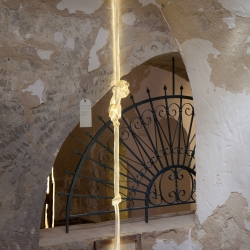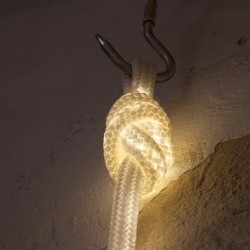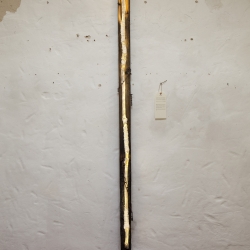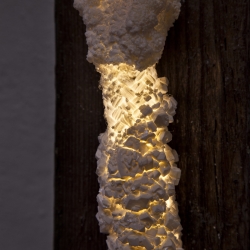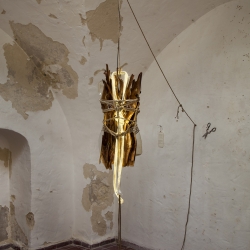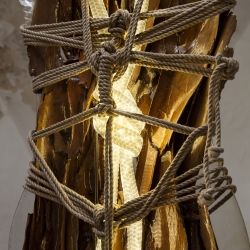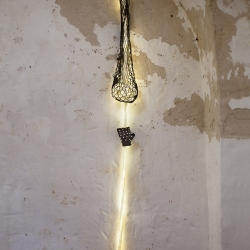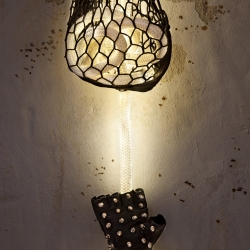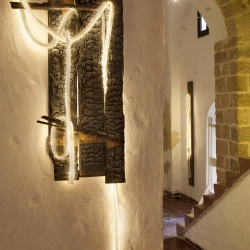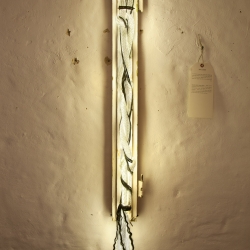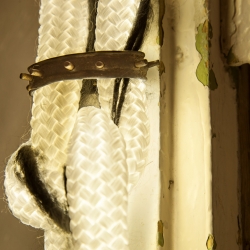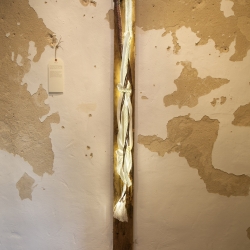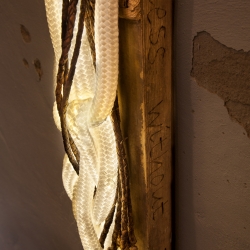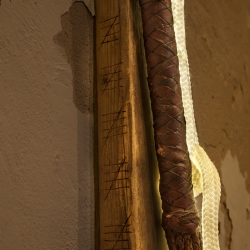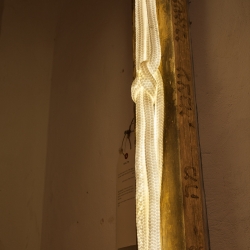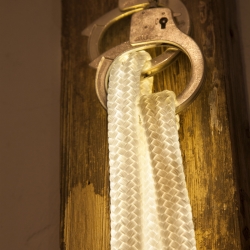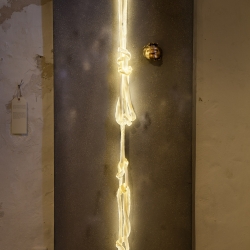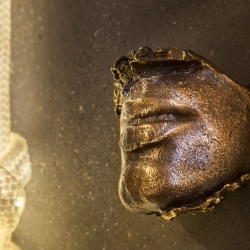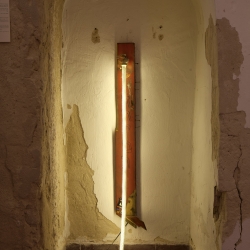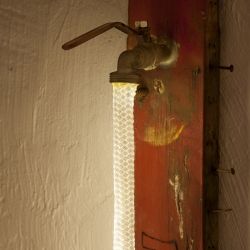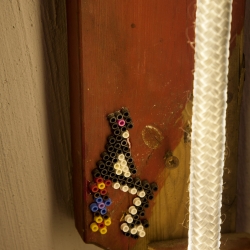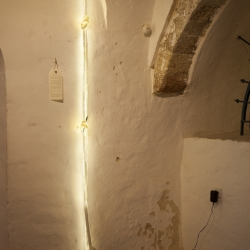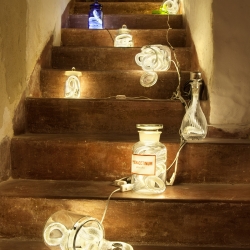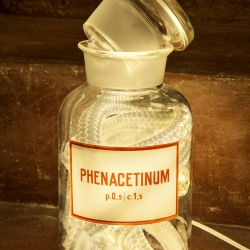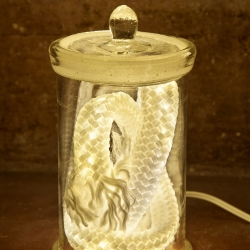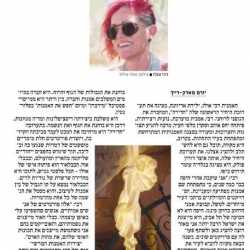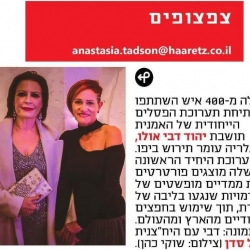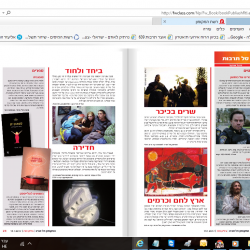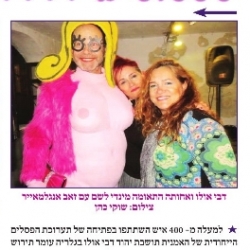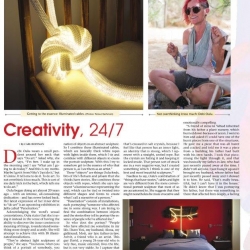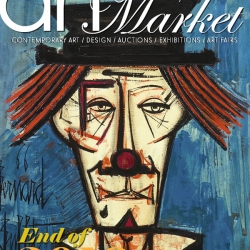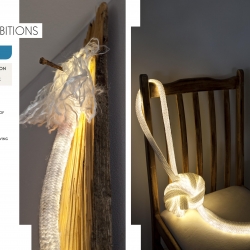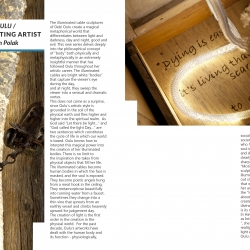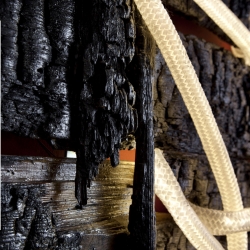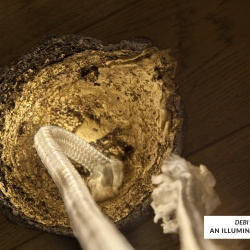Penetration – 2017 to present
Penetration – series exhibited in solo exhibition, January 5th – February 10th, 2017. Omer Tiroche Gallery, Jaffa Tel Aviv. Curator: Doron Polak
Penetration II – same series, new material exhibited in solo exhibition, December 15 2018 – January 20 2019, Art & About. Curator: Kalia Pissarro-Stern
Debi Oulu | Penetration – Solo Exhibition | Curator: Doron Pollock | Opening: Thursday, January 5, 2017, 20:00
Omer Tiroche Gallery | Mazal Moznaim 2 (Corner of Kikar Kedumim 8), Old Jaffa | www.omertiroche.com | T: 077 55 45773 | Gallery Hours: Mon-Fri 10:00 – 18:00
The exhibition will be showing January 5- February 10, 2017 |Illuminated Cable Sculptures -Abstract portraits of the inner essence
Debi Oulu / An Illuminating Artist – Doron Polak
The illuminated cable sculptures of Debi Oulu create a magical metaphorical world that differentiates between light and darkness, day and night, good and evil. This new series delves deeply into the philosophical concept of “body” both physically and metaphysically in an extremely insightful manner that has followed Oulu throughout her artistic career. The illuminated cables are bright white “bodies” that capture the viewer’s eye during the day, and at night, they sweep the viewer into a sensual and dramatic vortex.
This does not come as a surprise, since Oulu’s artistic style is grounded in the soil of the physical earth and flies higher and higher into the spiritual realm. As God said “Let there be light…” and “God called the light Day…” are two sentences which constitutes the cycle of life in which our world is based. Oulu knows how to interpret this magical power into the creation of her illuminated bodies. There is no limit to the inspiration she takes from physical objects that fill her life. The illuminated cables become human bodies in which the face is masked, and the soul is exposed. They become poetic angels hung from a meat hook in the ceiling. They metamorphose beautifully into running water from a faucet. Sometimes they change into a thin vine that sprouts from an earthly vessel and climbs heavenly upward for judgement day.
The creation of light is the first order in the creation in the physical world. For the past decade, Oulu’s artworks have dealt with the human body and its function – physiologically, socially and politically within our society. Debi Oulu is a bold artist who has dedicated her body and soul in conveying her thoughts and desires. Her new sculptures clearly express her emotions in a sharp and penetrating manner. “Moti” one of the most sublime sculptures in her exhibition has an illuminated cable swirling in and out of a burnt wooden structure that was salvaged from a fire. In her artwork, she confronts the term the “Hidden Light” which is spoken about in the Kabbalah. If man was created as a tool to receive the divine code, the illuminated cable is its means in which to receive it. In Haviva Pedaya’s essay, “Light as Internal and Light as a Sheath “, she says that we can experience reality as a space where physical light exists. This is in fact what Debi Oulu creates in her remarkable piece “Madeline”, in which a person must physically rejuvenate the light by peddling the bicycle.
Oulu’s “additions” of earthly found objects intertwine with the illuminating cables and are an integral part of her new three dimensional creations. She uses the same symbolism and allegories that we are familiar with in literature and poetry. These “additions” build the essence of the luminosity in Bialik’s poem, which magnifies the sublime light of divine truth liberating man from the chains. The meaning of the light, as we see deeply rooted in Debi Oulu’s white cables, is as Immanuel Kant Explains, “the illuminated light from within the world of the beholder”.
Debi Oulu’s illuminated artworks correspond with a long list of great artists throughout history who have engaged in the sensory and physical aspects of light. Rembrandt portrayed his spiritual holiness of God through the manipulation of light and shadows. Caspar David Friedrich used light to described the mental state of the person. In present day, James Turrell places the base of light, thus creating “space”. Dan Flavin’s creates human lines using neon lights. Israeli artist, Belu Fainaru uses light to express his vision of connecting the holy and the profane, and Motti Mizrachi portrays the “Israeli Pioneer” through light bulbs. In a latent dialog with these artists, Debi Oulu faces these concepts with her illuminated cables, creating her own unique inner world.
דבי אולו / אמנות מוארת דורון פולק
פסלי הכבלים המוארים של דבי אולו יוצרים עולם מטאפורי מושלם של אווירה קסומה המבדילה בין אור לחושך, בין יום ללילה בין הטוב לרע. סדרת היצירות החדשה מביאה אינטרפרטציה קיצונית למונח “הגוף” הפיזי והמטאפיזי, עליו אמונה בצורה כל כך מקצועית דבי אולו לאורך כל דרכה האמנותית. הכבלים המוארים אינם אלא – גופים לבנים מבהיקים, הלוכדים את עינו של הצופה בהם ביום וסוחפים אותו למערבולת חושנית ודרמטית בלילה.
לא יפלא, כי דבי אולו יוצרת אמנות, שמקורה באדמה ובקרקע הגשמית והרוויה והיא נישאת אל על ,מעלה מעלה אל העולם הרוחני. “ויאמר אלהים יהיה אור..” ו- ” ויקרא אלהים ליום אור…” הם שני המשפטים עליהם מורכב העולם ועליו מתנהל מחזור חיינו. דבי אולו יודעת לאבחן כוח מאגי מהו, והיא יוצרת ממנו את כבליה המוארים. אין גבול להשראה שהיא נוטלת מחפצים הגשמיים המרכיבים את חייה. הכבלים המוארים הופכים לגופים אנושיים עם פני מסכה עליהם, הם הופכים למלאכים פיוטיים התלויים על קרס תעשייתית מהתקרה, הם יוצרים מטאמורפוזה מפליאה והופכים למים הזורמים מברז ולעיתים הם הופכים לשיח דקיק המתפתל כלפי מעלה יוצא מכד מלא באדמה ופניו אל הרקיע.
אור הבריאה הוא האפשר את הסדר הראשוני בעולם הגשמי. יצירתה המתמשכת על פני עשורים של אולו, עוסקת בגוף, הנשי, הגברי, במקומו של הגוף בסדר החברתי והפוליטי הממלא את ימינו. דבי אולו היא יוצרת נועזת המקדישה את גופה ונפשה לביטוי מאווי חייה. הכבלים החדשים הם צינור ביטוי חריף ומוקצן לסדרת תחושותיה הנוכחית. יצירה מופלאה מרכזית בתערוכה עוסקת בכבל מואר המשתלשל מתוך מבנה עץ שרוף שניצל משריפה. יש בעבודה התעמתות ב”אור הגנוז” עליו מדברת תורת הקבלה. אם האדם נברא ככלי על מנת לקבל את הצופן האלוהי, הרי הכבל המואר הנו האמצעי לכך. חביבה פדיה כותבת במאמרה :”אור כתוך ואור כמעטפות” כי ניתן לחוות את המציאות כחלל שבו מתגלה אור מוחשי. ואכן, לדוגמא, דבי אולו יוצרת כבל מואר מדהים, אשר האור בו נוצר ממגע האדם המדווש על אופניו ויוצר אנרגיה מציאותית וגשמית המביאה את האור.
סדרת הקשרים, ה”פלונטרים היצירתיים” המבהיקים, המחוברים לגופי הכבלים המוארים היא חלק בלתי נפרד מהיצירה התלת ממדית החדשה. דבי אולו מביאה את אותם קשרים אלגוריים לכדי סימליות, המוכרת לנו מעולם ה”קשרים” בספרות ובשירה. קשרים אלה בונים את מהותו של ה”זוהר” בשירו של ביאליק ומבחינים שם בין האמת האלוהית הנשגבת לאור המשחרר את האדם מכבליו. את משמעותו של האור, כפי שבא לידי ביטוי ממעמקי הכבלים הלבנים של דבי אולו, מסביר עמנואל קאנט הפילוסוף, כ”אור המואר מתוך עולמו של המתבונן…” וזהו השימוש, שהאדם מקרין מהכרתו על ה”יש” החושי…”
יצירתה של דבי אולו באמנותה המוארת מתחברת לאמנים העוסקים באור החושי והגשמי לאורכה של ההיסטוריה. רמברנדט הציג באור הרוחני שלו את הקדושה האלוהית, קספר דוד פרידריך תיאר את מצבו המנטאלי של האדם באמצעות האור הנשגב המצויר שלו ובעידן הנוכחי, מדגימים ג’יימס טורל, המנכיח את האור בחלל וכך יוצר אותו ודן פלבין האמריקאי הבונה קווים אנושיים בחלל, באמצעות הפיסול הנאוני שלו. באמנות הישראלית מפליא בלו פיינרו להשתמש באור להבעת חזונו המחבר בין החול לקודש, ומוטי מזרחי מאפיין את דמותו של ה”חלוץ” הישראלי אמצעות נורות האור. דבי אולו מתעמתת עם כל אלה ויוצרת בעזרת כבליה המוארים את עולמה הייחודי והפנימי, המהווה דיאלוג לטנטי עם אותם יוצרים


